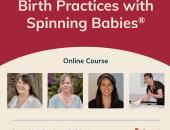Principle 1: Balance (your uterus)
Balance simply means the muscles are not too tight or loose, and the ligaments to the uterus are not twisted. The surges of the womb, commonly known as contractions, help position the baby by rotating and flexing the baby’s head — if the muscles and ligaments don’t interfere through some significant tightness (or looseness).
By releasing the chronic tension caused by sitting in chairs, driving, old falls, and accidents, etc., you can relax your broad and round ligaments to let the baby rotate past them in labor.
When a poorly-positioned baby is too low in a tight pelvis to rotate to a better position, we can soften the muscles and ligaments of the pelvis to give the pelvis more flexible. This may allow the baby to dropdown.
Some babies will fit even when posterior or asynclitic (tipped). Balance can truly help open the way!
Effective balance activities:
- Daily and Weekly Pregnancy Activities
- Rebozo Manteada
- Abdominal Release
- Forward-Leaning Inversion
- Side-lying Release
- Standing Sacral Release
- Dip the Hip
If you’ve given birth before, and labor went well, labor is likely to go well again. If it was hard, then these techniques may make a wonderful difference. Labor contractions may help reposition your baby by softening the lower uterine segment over time. Changing your positions in labor can be quite helpful.
Some women, however, may need a professional bodyworker to achieve the ease in birth they desire. I like to look for someone who knows myofascial release and therapeutic massage for pregnancy (not pregnancy massage for relaxation).
If doing the daily and weekly activities haven’t worked within three weeks (or sooner if you are due within the month), then you may want to seek professional assistance.
Principle 2: Gravity
Gravity and movement do help and will be enough for some women. Other women may need help to overcome a tight muscle or short ligament to achieve natural labor. When getting out of bed and moving isn’t enough, go back to balance.
Apply gravity using maternal positioning. When your uterine tone is made flexible, the maternal positioning techniques you are using will be much more effective.
A common misconception is that you need to be standing to apply gravity. This is not the case. You can rest using gravity, too. If you rest smart℠ you can actually help labor to continue while you relax. Lying with your top leg lifted by a peanut ball is a clever example of this.
Are you ready to be upright?
Try sitting on a birth stool. Don’t have a birth stool? Oh, yes you do! Every home and hospital room has a porcelain birthing stool (in the bathroom).
The birthing stool allows your hips to be level with your knees. Sit for three contractions and then stand for one. This keeps swelling in your tender places to a minimum. Then sit again for three and stand for one. If it’s hot and humid in the summer, stand for three instead to give more time for the fluid to move in your tissues before sitting. When you are up, make sure you’re standing with knees soft (not locked) and leaning over a friend or a counter-top, etc. for support.
Gravity in labor
Kneeling and leaning over a birth ball is a good choice. Let your knees remain further from your belly, rather than folded up near the ball and your belly. Don’t worry about lying mostly on your left side. The right side is good too unless your providers tell you otherwise. Changing your position every 30 minutes to 2 hours is best, but it’s no reason to wake a sleeping woman to have her change position unless it is medically necessary.
Principle 3: Movement (of the mother)
Movement helps reduce pain and can help the baby go lower. When you do feel the need to move, do it! Move around. Be vertical. It’s surprising how often women find being up and moving makes labor more manageable than lying on their hips or their back in bed.
You’ve already released some constriction by bringing your body into a better balance. You are being mindful of gravity-friendly positions. Now, you may need to move your pelvis to help your baby shift down.
Pelvic mobility
Pelvic mobility may increase the chance for the baby to rotate. If the baby doesn’t change position during the pregnancy, doing the following things will help the pelvis be more mobile in labor so the baby can rotate more easily by the action of the contractions.
When the baby is active:
- Do circles on a birth ball
- Put some music on, and show off your belly dancer moves!
- Get down on your hands and knees and do 40 pelvic rocks
- Do the Forward-leaning Inversion
- Go for a swim in deep water. A submerged belly makes it easier for the baby to adjust its position. (Just know that the time it takes to drive to a pool may put the baby back to sleep.)
If the movement doesn’t work, check, and see if the baby is truly engaged. Try those techniques, and then return to balancing activities.






